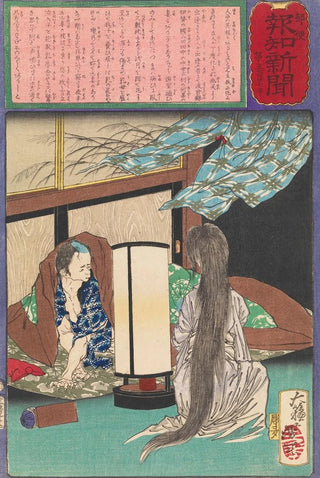Painting A widower sees the ghost of his wife breastfeeding their child - Tsukioka Yoshitoshi | Art print


View from behind

Frame (optional)
A widower sees the ghost of his wife breastfeeding their child: a poignant scene between life and death
In this emotive art print, Tsukioka Yoshitoshi captures a moment that is both tender and tragic. The artwork depicts a widower, immersed in melancholy, contemplating the specter of his wife feeding their child. The soft colors and delicate nuances create an almost ethereal atmosphere, where the real and the unreal meet. The ukiyo-e technique, typical of the ukiyo-e, allows for the transmission of deep emotions through meticulous details and harmonious compositions. The viewer's gaze is immediately drawn to the maternal figure, symbol of love and loss, who seems to float in a world between the living and the dead.
Tsukioka Yoshitoshi: a master of Japanese art prints of the 19th century
Tsukioka Yoshitoshi, one of the last great masters of ukiyo-e, marked his era with works that blend tradition and innovation. Born in 1839, he was influenced by the social and political upheavals of Japan, notably the transition to modernity. His art prints, often inspired by legends and historical narratives, reveal a unique sensitivity and remarkable technical mastery. Yoshitoshi was able to capture complex human emotions, making his works timeless. His legacy endures, and he is today recognized as one of the most influential artists of his time, having redefined the codes of Japanese art print.
A decorative acquisition with multiple assets
The art print of "A widower sees the ghost of his wife breastfeeding their child" is a centerpiece that will enrich your interior decoration. Whether in a living room, office, or bedroom, this artwork evokes profound reflections on love and loss, while adding a touch of elegance. The quality of the reproduction guarantees fidelity to the original details, allowing you to feel the full emotional power of the piece. With its undeniable aesthetic appeal, this canvas becomes not only a decorative element but also a true conversation piece, captivating all who contemplate it.

Matte finish

View from behind

Frame (optional)
A widower sees the ghost of his wife breastfeeding their child: a poignant scene between life and death
In this emotive art print, Tsukioka Yoshitoshi captures a moment that is both tender and tragic. The artwork depicts a widower, immersed in melancholy, contemplating the specter of his wife feeding their child. The soft colors and delicate nuances create an almost ethereal atmosphere, where the real and the unreal meet. The ukiyo-e technique, typical of the ukiyo-e, allows for the transmission of deep emotions through meticulous details and harmonious compositions. The viewer's gaze is immediately drawn to the maternal figure, symbol of love and loss, who seems to float in a world between the living and the dead.
Tsukioka Yoshitoshi: a master of Japanese art prints of the 19th century
Tsukioka Yoshitoshi, one of the last great masters of ukiyo-e, marked his era with works that blend tradition and innovation. Born in 1839, he was influenced by the social and political upheavals of Japan, notably the transition to modernity. His art prints, often inspired by legends and historical narratives, reveal a unique sensitivity and remarkable technical mastery. Yoshitoshi was able to capture complex human emotions, making his works timeless. His legacy endures, and he is today recognized as one of the most influential artists of his time, having redefined the codes of Japanese art print.
A decorative acquisition with multiple assets
The art print of "A widower sees the ghost of his wife breastfeeding their child" is a centerpiece that will enrich your interior decoration. Whether in a living room, office, or bedroom, this artwork evokes profound reflections on love and loss, while adding a touch of elegance. The quality of the reproduction guarantees fidelity to the original details, allowing you to feel the full emotional power of the piece. With its undeniable aesthetic appeal, this canvas becomes not only a decorative element but also a true conversation piece, captivating all who contemplate it.
12,34 €






